Addressing Health Inequalities through Government Initiatives
VerifiedAdded on 2020/09/17
|7
|2187
|68
Essay
AI Summary
The essay discusses the influence of socio-economic factors on individual health, highlighting barriers like health inequity and illiteracy that limit access to healthcare services. Various government reports underscore these disparities, suggesting a need for targeted policy actions. Initiatives such as Sure Start and Health Action Zones are examined as efforts to mitigate these challenges, emphasizing the importance of awareness and communication among community members about protective laws and policies.
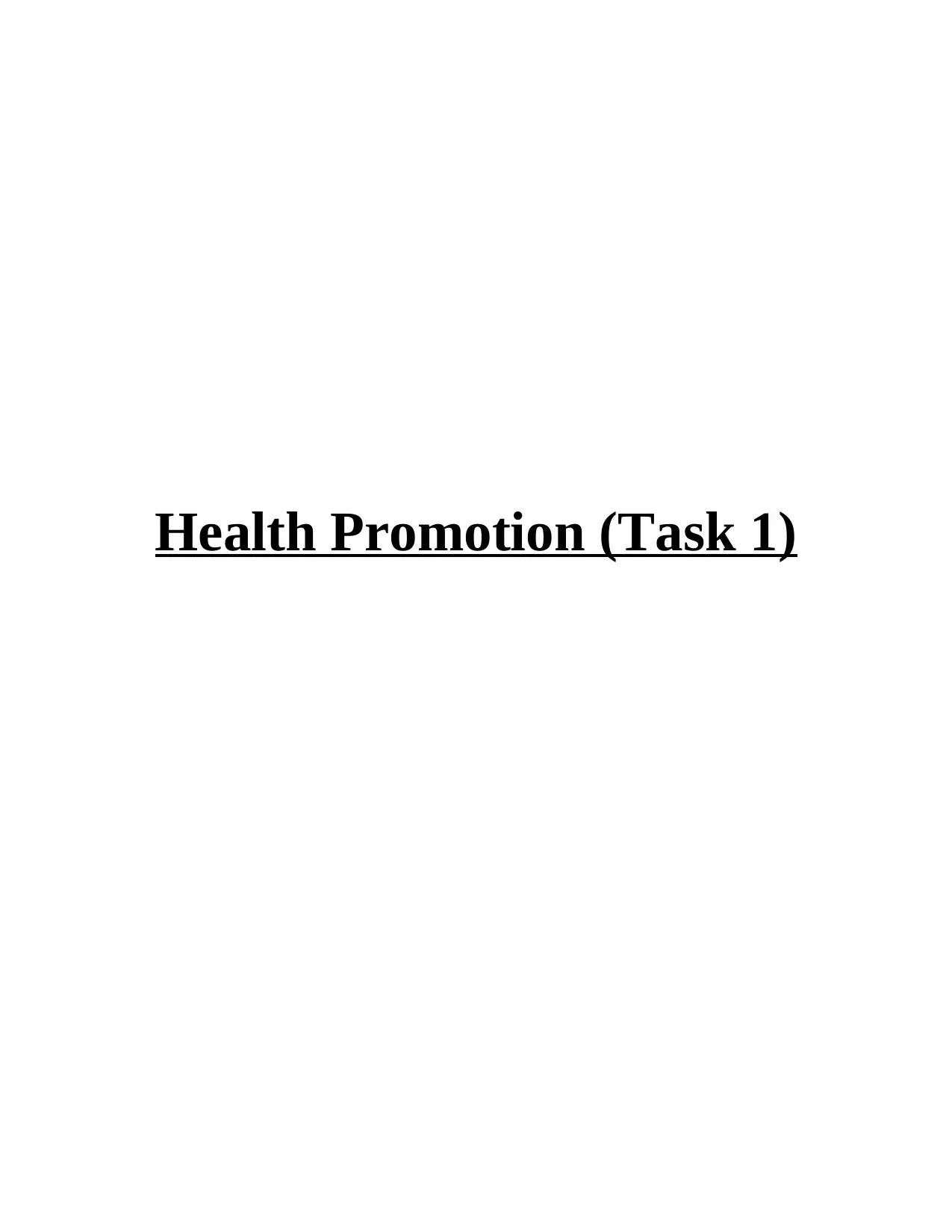
Health Promotion (Task 1)
Paraphrase This Document
Need a fresh take? Get an instant paraphrase of this document with our AI Paraphraser
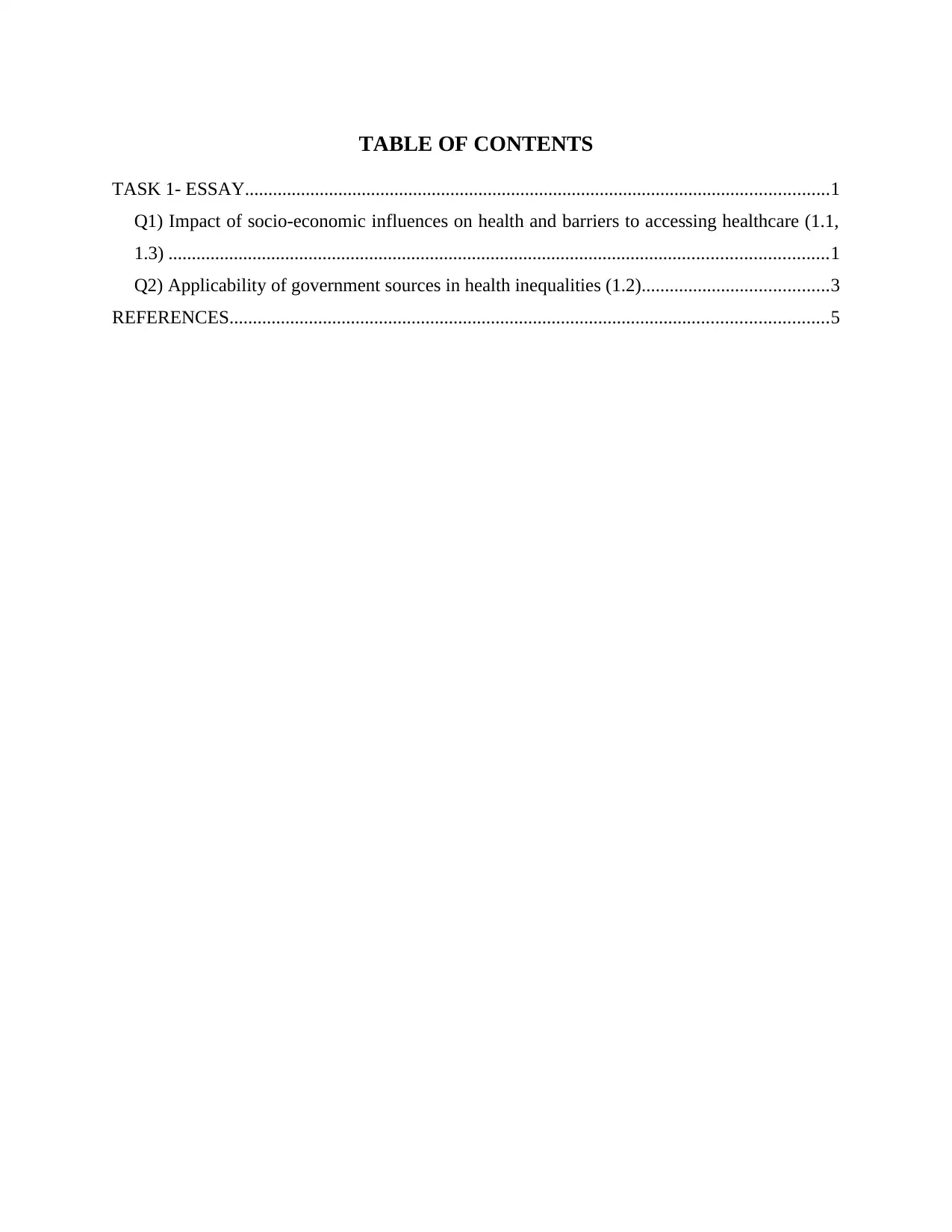
TABLE OF CONTENTS
TASK 1- ESSAY.............................................................................................................................1
Q1) Impact of socio-economic influences on health and barriers to accessing healthcare (1.1,
1.3) .............................................................................................................................................1
Q2) Applicability of government sources in health inequalities (1.2)........................................3
REFERENCES................................................................................................................................5
TASK 1- ESSAY.............................................................................................................................1
Q1) Impact of socio-economic influences on health and barriers to accessing healthcare (1.1,
1.3) .............................................................................................................................................1
Q2) Applicability of government sources in health inequalities (1.2)........................................3
REFERENCES................................................................................................................................5
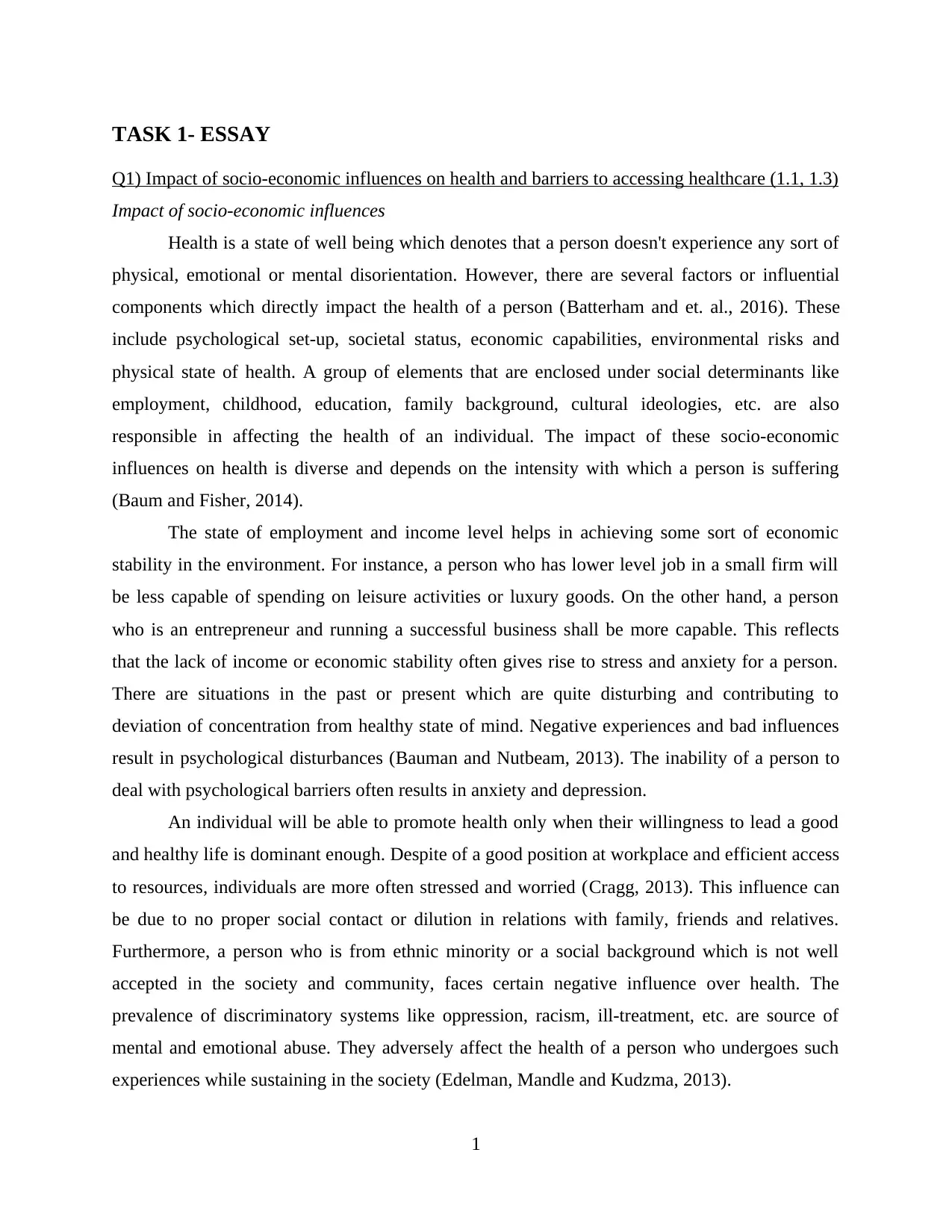
TASK 1- ESSAY
Q1) Impact of socio-economic influences on health and barriers to accessing healthcare (1.1, 1.3)
Impact of socio-economic influences
Health is a state of well being which denotes that a person doesn't experience any sort of
physical, emotional or mental disorientation. However, there are several factors or influential
components which directly impact the health of a person (Batterham and et. al., 2016). These
include psychological set-up, societal status, economic capabilities, environmental risks and
physical state of health. A group of elements that are enclosed under social determinants like
employment, childhood, education, family background, cultural ideologies, etc. are also
responsible in affecting the health of an individual. The impact of these socio-economic
influences on health is diverse and depends on the intensity with which a person is suffering
(Baum and Fisher, 2014).
The state of employment and income level helps in achieving some sort of economic
stability in the environment. For instance, a person who has lower level job in a small firm will
be less capable of spending on leisure activities or luxury goods. On the other hand, a person
who is an entrepreneur and running a successful business shall be more capable. This reflects
that the lack of income or economic stability often gives rise to stress and anxiety for a person.
There are situations in the past or present which are quite disturbing and contributing to
deviation of concentration from healthy state of mind. Negative experiences and bad influences
result in psychological disturbances (Bauman and Nutbeam, 2013). The inability of a person to
deal with psychological barriers often results in anxiety and depression.
An individual will be able to promote health only when their willingness to lead a good
and healthy life is dominant enough. Despite of a good position at workplace and efficient access
to resources, individuals are more often stressed and worried (Cragg, 2013). This influence can
be due to no proper social contact or dilution in relations with family, friends and relatives.
Furthermore, a person who is from ethnic minority or a social background which is not well
accepted in the society and community, faces certain negative influence over health. The
prevalence of discriminatory systems like oppression, racism, ill-treatment, etc. are source of
mental and emotional abuse. They adversely affect the health of a person who undergoes such
experiences while sustaining in the society (Edelman, Mandle and Kudzma, 2013).
1
Q1) Impact of socio-economic influences on health and barriers to accessing healthcare (1.1, 1.3)
Impact of socio-economic influences
Health is a state of well being which denotes that a person doesn't experience any sort of
physical, emotional or mental disorientation. However, there are several factors or influential
components which directly impact the health of a person (Batterham and et. al., 2016). These
include psychological set-up, societal status, economic capabilities, environmental risks and
physical state of health. A group of elements that are enclosed under social determinants like
employment, childhood, education, family background, cultural ideologies, etc. are also
responsible in affecting the health of an individual. The impact of these socio-economic
influences on health is diverse and depends on the intensity with which a person is suffering
(Baum and Fisher, 2014).
The state of employment and income level helps in achieving some sort of economic
stability in the environment. For instance, a person who has lower level job in a small firm will
be less capable of spending on leisure activities or luxury goods. On the other hand, a person
who is an entrepreneur and running a successful business shall be more capable. This reflects
that the lack of income or economic stability often gives rise to stress and anxiety for a person.
There are situations in the past or present which are quite disturbing and contributing to
deviation of concentration from healthy state of mind. Negative experiences and bad influences
result in psychological disturbances (Bauman and Nutbeam, 2013). The inability of a person to
deal with psychological barriers often results in anxiety and depression.
An individual will be able to promote health only when their willingness to lead a good
and healthy life is dominant enough. Despite of a good position at workplace and efficient access
to resources, individuals are more often stressed and worried (Cragg, 2013). This influence can
be due to no proper social contact or dilution in relations with family, friends and relatives.
Furthermore, a person who is from ethnic minority or a social background which is not well
accepted in the society and community, faces certain negative influence over health. The
prevalence of discriminatory systems like oppression, racism, ill-treatment, etc. are source of
mental and emotional abuse. They adversely affect the health of a person who undergoes such
experiences while sustaining in the society (Edelman, Mandle and Kudzma, 2013).
1
⊘ This is a preview!⊘
Do you want full access?
Subscribe today to unlock all pages.

Trusted by 1+ million students worldwide
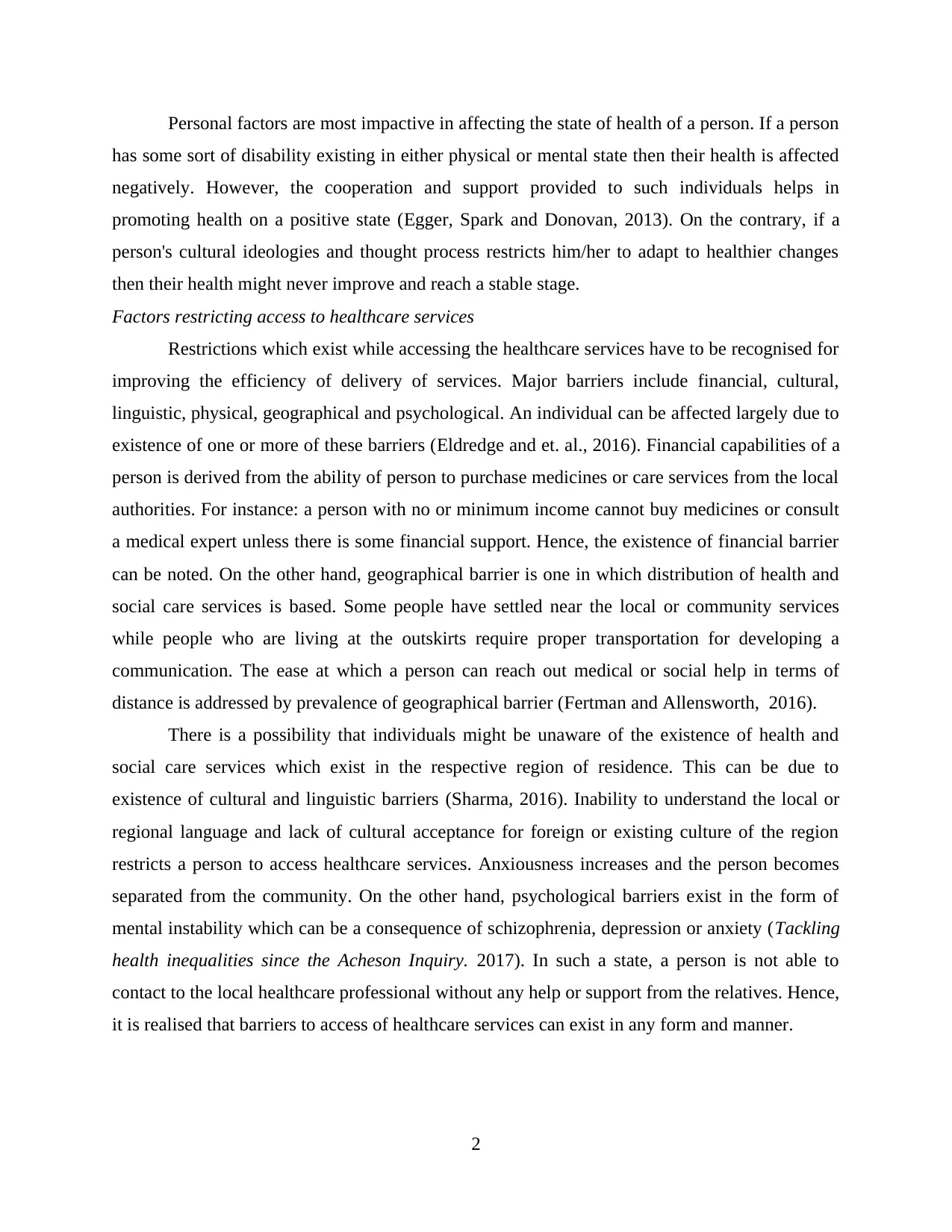
Personal factors are most impactive in affecting the state of health of a person. If a person
has some sort of disability existing in either physical or mental state then their health is affected
negatively. However, the cooperation and support provided to such individuals helps in
promoting health on a positive state (Egger, Spark and Donovan, 2013). On the contrary, if a
person's cultural ideologies and thought process restricts him/her to adapt to healthier changes
then their health might never improve and reach a stable stage.
Factors restricting access to healthcare services
Restrictions which exist while accessing the healthcare services have to be recognised for
improving the efficiency of delivery of services. Major barriers include financial, cultural,
linguistic, physical, geographical and psychological. An individual can be affected largely due to
existence of one or more of these barriers (Eldredge and et. al., 2016). Financial capabilities of a
person is derived from the ability of person to purchase medicines or care services from the local
authorities. For instance: a person with no or minimum income cannot buy medicines or consult
a medical expert unless there is some financial support. Hence, the existence of financial barrier
can be noted. On the other hand, geographical barrier is one in which distribution of health and
social care services is based. Some people have settled near the local or community services
while people who are living at the outskirts require proper transportation for developing a
communication. The ease at which a person can reach out medical or social help in terms of
distance is addressed by prevalence of geographical barrier (Fertman and Allensworth, 2016).
There is a possibility that individuals might be unaware of the existence of health and
social care services which exist in the respective region of residence. This can be due to
existence of cultural and linguistic barriers (Sharma, 2016). Inability to understand the local or
regional language and lack of cultural acceptance for foreign or existing culture of the region
restricts a person to access healthcare services. Anxiousness increases and the person becomes
separated from the community. On the other hand, psychological barriers exist in the form of
mental instability which can be a consequence of schizophrenia, depression or anxiety (Tackling
health inequalities since the Acheson Inquiry. 2017). In such a state, a person is not able to
contact to the local healthcare professional without any help or support from the relatives. Hence,
it is realised that barriers to access of healthcare services can exist in any form and manner.
2
has some sort of disability existing in either physical or mental state then their health is affected
negatively. However, the cooperation and support provided to such individuals helps in
promoting health on a positive state (Egger, Spark and Donovan, 2013). On the contrary, if a
person's cultural ideologies and thought process restricts him/her to adapt to healthier changes
then their health might never improve and reach a stable stage.
Factors restricting access to healthcare services
Restrictions which exist while accessing the healthcare services have to be recognised for
improving the efficiency of delivery of services. Major barriers include financial, cultural,
linguistic, physical, geographical and psychological. An individual can be affected largely due to
existence of one or more of these barriers (Eldredge and et. al., 2016). Financial capabilities of a
person is derived from the ability of person to purchase medicines or care services from the local
authorities. For instance: a person with no or minimum income cannot buy medicines or consult
a medical expert unless there is some financial support. Hence, the existence of financial barrier
can be noted. On the other hand, geographical barrier is one in which distribution of health and
social care services is based. Some people have settled near the local or community services
while people who are living at the outskirts require proper transportation for developing a
communication. The ease at which a person can reach out medical or social help in terms of
distance is addressed by prevalence of geographical barrier (Fertman and Allensworth, 2016).
There is a possibility that individuals might be unaware of the existence of health and
social care services which exist in the respective region of residence. This can be due to
existence of cultural and linguistic barriers (Sharma, 2016). Inability to understand the local or
regional language and lack of cultural acceptance for foreign or existing culture of the region
restricts a person to access healthcare services. Anxiousness increases and the person becomes
separated from the community. On the other hand, psychological barriers exist in the form of
mental instability which can be a consequence of schizophrenia, depression or anxiety (Tackling
health inequalities since the Acheson Inquiry. 2017). In such a state, a person is not able to
contact to the local healthcare professional without any help or support from the relatives. Hence,
it is realised that barriers to access of healthcare services can exist in any form and manner.
2
Paraphrase This Document
Need a fresh take? Get an instant paraphrase of this document with our AI Paraphraser
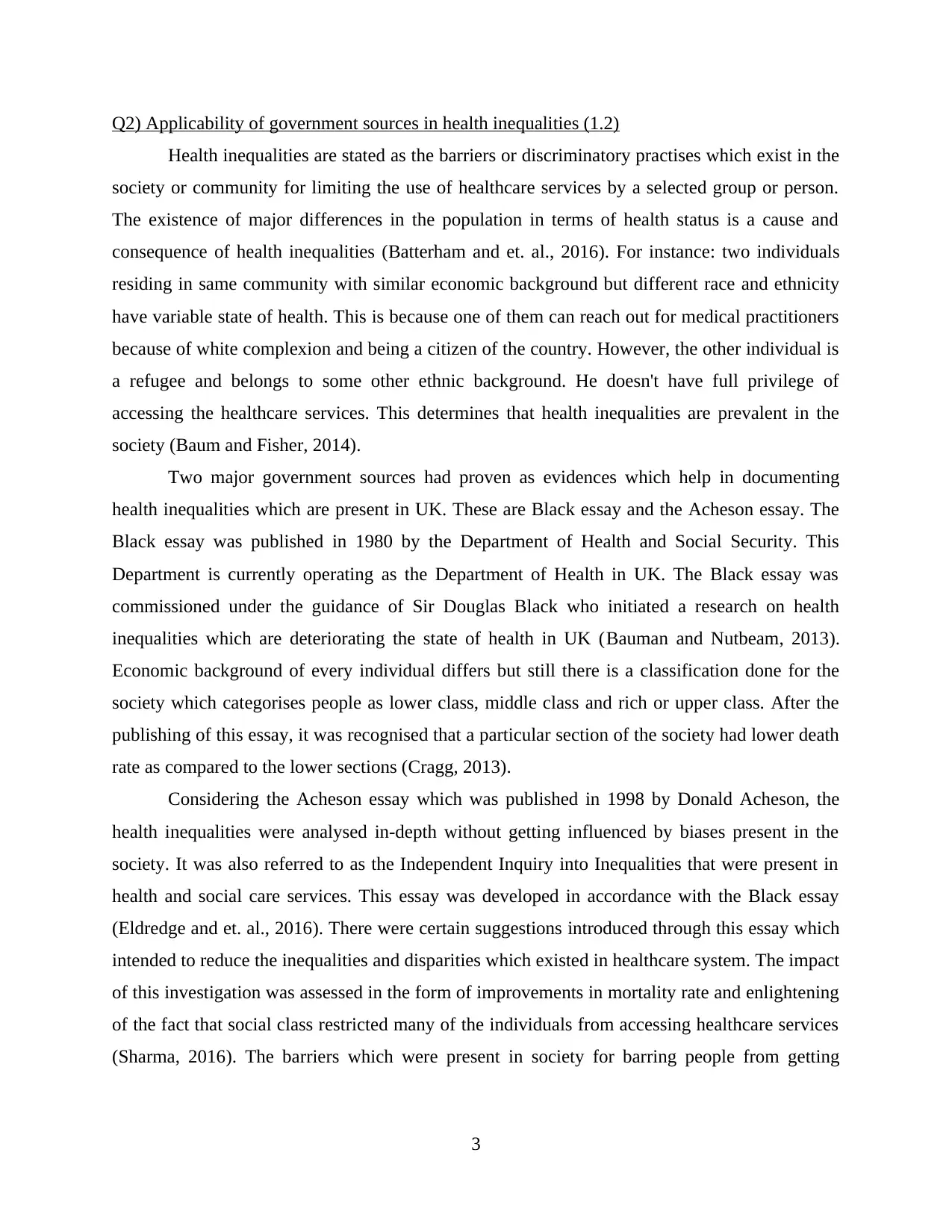
Q2) Applicability of government sources in health inequalities (1.2)
Health inequalities are stated as the barriers or discriminatory practises which exist in the
society or community for limiting the use of healthcare services by a selected group or person.
The existence of major differences in the population in terms of health status is a cause and
consequence of health inequalities (Batterham and et. al., 2016). For instance: two individuals
residing in same community with similar economic background but different race and ethnicity
have variable state of health. This is because one of them can reach out for medical practitioners
because of white complexion and being a citizen of the country. However, the other individual is
a refugee and belongs to some other ethnic background. He doesn't have full privilege of
accessing the healthcare services. This determines that health inequalities are prevalent in the
society (Baum and Fisher, 2014).
Two major government sources had proven as evidences which help in documenting
health inequalities which are present in UK. These are Black essay and the Acheson essay. The
Black essay was published in 1980 by the Department of Health and Social Security. This
Department is currently operating as the Department of Health in UK. The Black essay was
commissioned under the guidance of Sir Douglas Black who initiated a research on health
inequalities which are deteriorating the state of health in UK (Bauman and Nutbeam, 2013).
Economic background of every individual differs but still there is a classification done for the
society which categorises people as lower class, middle class and rich or upper class. After the
publishing of this essay, it was recognised that a particular section of the society had lower death
rate as compared to the lower sections (Cragg, 2013).
Considering the Acheson essay which was published in 1998 by Donald Acheson, the
health inequalities were analysed in-depth without getting influenced by biases present in the
society. It was also referred to as the Independent Inquiry into Inequalities that were present in
health and social care services. This essay was developed in accordance with the Black essay
(Eldredge and et. al., 2016). There were certain suggestions introduced through this essay which
intended to reduce the inequalities and disparities which existed in healthcare system. The impact
of this investigation was assessed in the form of improvements in mortality rate and enlightening
of the fact that social class restricted many of the individuals from accessing healthcare services
(Sharma, 2016). The barriers which were present in society for barring people from getting
3
Health inequalities are stated as the barriers or discriminatory practises which exist in the
society or community for limiting the use of healthcare services by a selected group or person.
The existence of major differences in the population in terms of health status is a cause and
consequence of health inequalities (Batterham and et. al., 2016). For instance: two individuals
residing in same community with similar economic background but different race and ethnicity
have variable state of health. This is because one of them can reach out for medical practitioners
because of white complexion and being a citizen of the country. However, the other individual is
a refugee and belongs to some other ethnic background. He doesn't have full privilege of
accessing the healthcare services. This determines that health inequalities are prevalent in the
society (Baum and Fisher, 2014).
Two major government sources had proven as evidences which help in documenting
health inequalities which are present in UK. These are Black essay and the Acheson essay. The
Black essay was published in 1980 by the Department of Health and Social Security. This
Department is currently operating as the Department of Health in UK. The Black essay was
commissioned under the guidance of Sir Douglas Black who initiated a research on health
inequalities which are deteriorating the state of health in UK (Bauman and Nutbeam, 2013).
Economic background of every individual differs but still there is a classification done for the
society which categorises people as lower class, middle class and rich or upper class. After the
publishing of this essay, it was recognised that a particular section of the society had lower death
rate as compared to the lower sections (Cragg, 2013).
Considering the Acheson essay which was published in 1998 by Donald Acheson, the
health inequalities were analysed in-depth without getting influenced by biases present in the
society. It was also referred to as the Independent Inquiry into Inequalities that were present in
health and social care services. This essay was developed in accordance with the Black essay
(Eldredge and et. al., 2016). There were certain suggestions introduced through this essay which
intended to reduce the inequalities and disparities which existed in healthcare system. The impact
of this investigation was assessed in the form of improvements in mortality rate and enlightening
of the fact that social class restricted many of the individuals from accessing healthcare services
(Sharma, 2016). The barriers which were present in society for barring people from getting
3
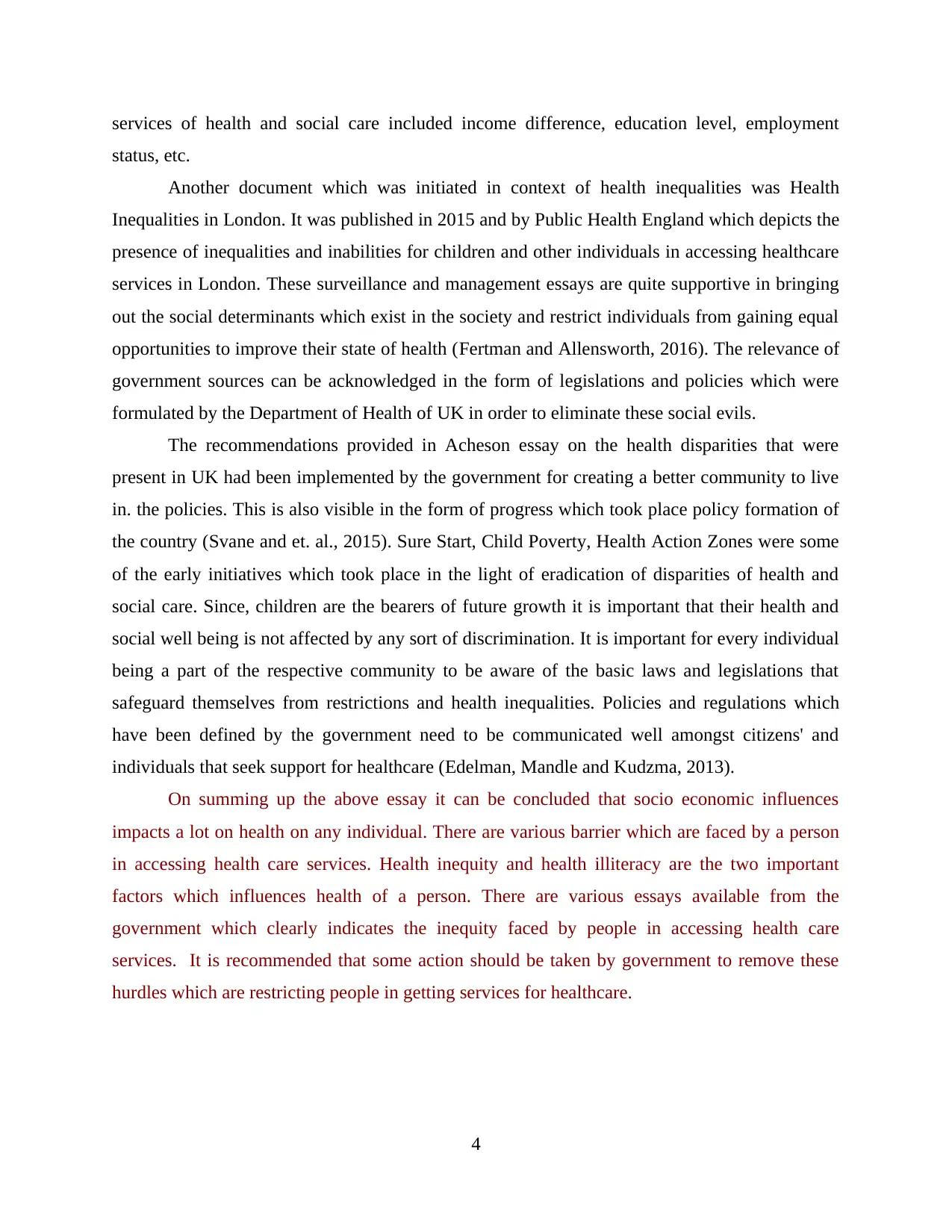
services of health and social care included income difference, education level, employment
status, etc.
Another document which was initiated in context of health inequalities was Health
Inequalities in London. It was published in 2015 and by Public Health England which depicts the
presence of inequalities and inabilities for children and other individuals in accessing healthcare
services in London. These surveillance and management essays are quite supportive in bringing
out the social determinants which exist in the society and restrict individuals from gaining equal
opportunities to improve their state of health (Fertman and Allensworth, 2016). The relevance of
government sources can be acknowledged in the form of legislations and policies which were
formulated by the Department of Health of UK in order to eliminate these social evils.
The recommendations provided in Acheson essay on the health disparities that were
present in UK had been implemented by the government for creating a better community to live
in. the policies. This is also visible in the form of progress which took place policy formation of
the country (Svane and et. al., 2015). Sure Start, Child Poverty, Health Action Zones were some
of the early initiatives which took place in the light of eradication of disparities of health and
social care. Since, children are the bearers of future growth it is important that their health and
social well being is not affected by any sort of discrimination. It is important for every individual
being a part of the respective community to be aware of the basic laws and legislations that
safeguard themselves from restrictions and health inequalities. Policies and regulations which
have been defined by the government need to be communicated well amongst citizens' and
individuals that seek support for healthcare (Edelman, Mandle and Kudzma, 2013).
On summing up the above essay it can be concluded that socio economic influences
impacts a lot on health on any individual. There are various barrier which are faced by a person
in accessing health care services. Health inequity and health illiteracy are the two important
factors which influences health of a person. There are various essays available from the
government which clearly indicates the inequity faced by people in accessing health care
services. It is recommended that some action should be taken by government to remove these
hurdles which are restricting people in getting services for healthcare.
4
status, etc.
Another document which was initiated in context of health inequalities was Health
Inequalities in London. It was published in 2015 and by Public Health England which depicts the
presence of inequalities and inabilities for children and other individuals in accessing healthcare
services in London. These surveillance and management essays are quite supportive in bringing
out the social determinants which exist in the society and restrict individuals from gaining equal
opportunities to improve their state of health (Fertman and Allensworth, 2016). The relevance of
government sources can be acknowledged in the form of legislations and policies which were
formulated by the Department of Health of UK in order to eliminate these social evils.
The recommendations provided in Acheson essay on the health disparities that were
present in UK had been implemented by the government for creating a better community to live
in. the policies. This is also visible in the form of progress which took place policy formation of
the country (Svane and et. al., 2015). Sure Start, Child Poverty, Health Action Zones were some
of the early initiatives which took place in the light of eradication of disparities of health and
social care. Since, children are the bearers of future growth it is important that their health and
social well being is not affected by any sort of discrimination. It is important for every individual
being a part of the respective community to be aware of the basic laws and legislations that
safeguard themselves from restrictions and health inequalities. Policies and regulations which
have been defined by the government need to be communicated well amongst citizens' and
individuals that seek support for healthcare (Edelman, Mandle and Kudzma, 2013).
On summing up the above essay it can be concluded that socio economic influences
impacts a lot on health on any individual. There are various barrier which are faced by a person
in accessing health care services. Health inequity and health illiteracy are the two important
factors which influences health of a person. There are various essays available from the
government which clearly indicates the inequity faced by people in accessing health care
services. It is recommended that some action should be taken by government to remove these
hurdles which are restricting people in getting services for healthcare.
4
⊘ This is a preview!⊘
Do you want full access?
Subscribe today to unlock all pages.

Trusted by 1+ million students worldwide
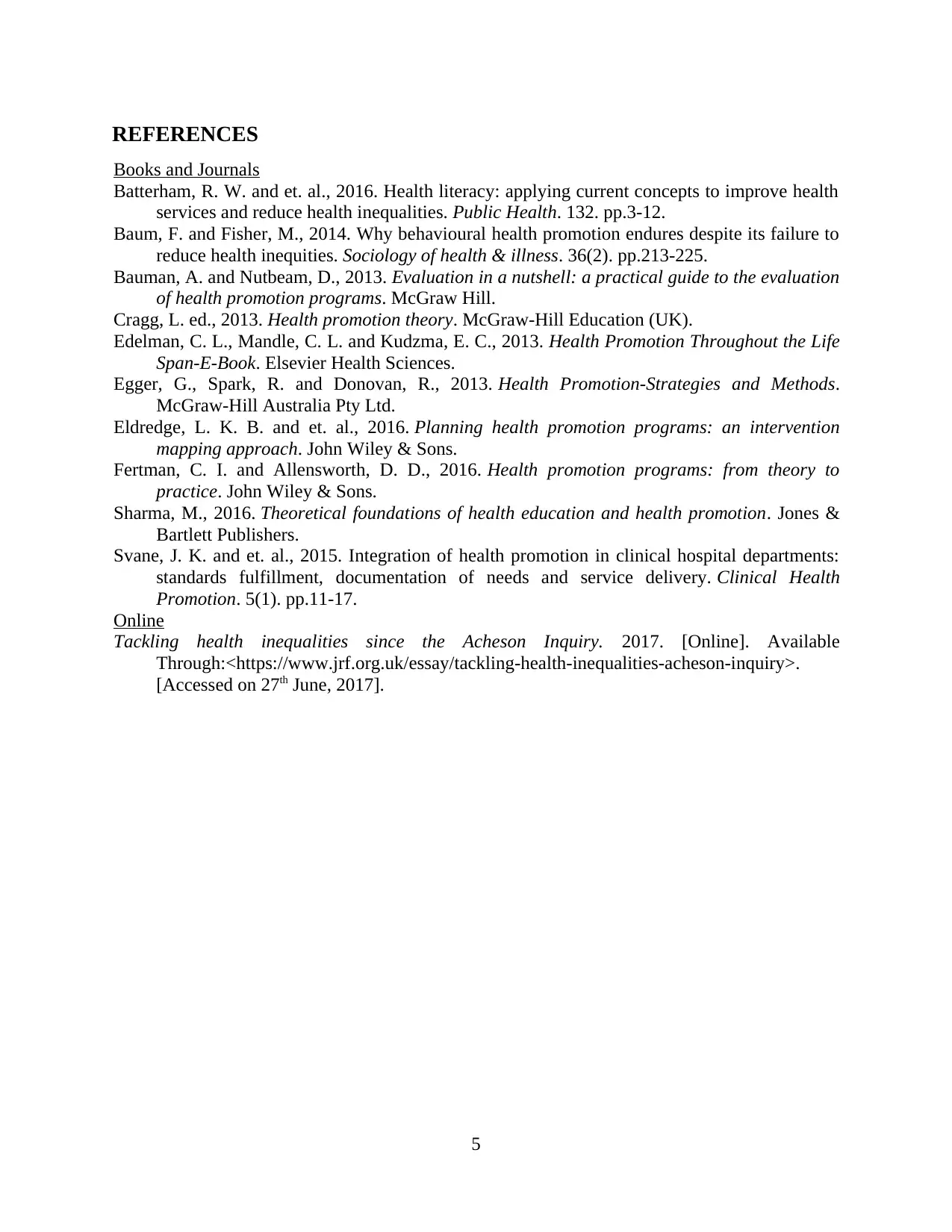
REFERENCES
Books and Journals
Batterham, R. W. and et. al., 2016. Health literacy: applying current concepts to improve health
services and reduce health inequalities. Public Health. 132. pp.3-12.
Baum, F. and Fisher, M., 2014. Why behavioural health promotion endures despite its failure to
reduce health inequities. Sociology of health & illness. 36(2). pp.213-225.
Bauman, A. and Nutbeam, D., 2013. Evaluation in a nutshell: a practical guide to the evaluation
of health promotion programs. McGraw Hill.
Cragg, L. ed., 2013. Health promotion theory. McGraw-Hill Education (UK).
Edelman, C. L., Mandle, C. L. and Kudzma, E. C., 2013. Health Promotion Throughout the Life
Span-E-Book. Elsevier Health Sciences.
Egger, G., Spark, R. and Donovan, R., 2013. Health Promotion-Strategies and Methods.
McGraw-Hill Australia Pty Ltd.
Eldredge, L. K. B. and et. al., 2016. Planning health promotion programs: an intervention
mapping approach. John Wiley & Sons.
Fertman, C. I. and Allensworth, D. D., 2016. Health promotion programs: from theory to
practice. John Wiley & Sons.
Sharma, M., 2016. Theoretical foundations of health education and health promotion. Jones &
Bartlett Publishers.
Svane, J. K. and et. al., 2015. Integration of health promotion in clinical hospital departments:
standards fulfillment, documentation of needs and service delivery. Clinical Health
Promotion. 5(1). pp.11-17.
Online
Tackling health inequalities since the Acheson Inquiry. 2017. [Online]. Available
Through:<https://www.jrf.org.uk/essay/tackling-health-inequalities-acheson-inquiry>.
[Accessed on 27th June, 2017].
5
Books and Journals
Batterham, R. W. and et. al., 2016. Health literacy: applying current concepts to improve health
services and reduce health inequalities. Public Health. 132. pp.3-12.
Baum, F. and Fisher, M., 2014. Why behavioural health promotion endures despite its failure to
reduce health inequities. Sociology of health & illness. 36(2). pp.213-225.
Bauman, A. and Nutbeam, D., 2013. Evaluation in a nutshell: a practical guide to the evaluation
of health promotion programs. McGraw Hill.
Cragg, L. ed., 2013. Health promotion theory. McGraw-Hill Education (UK).
Edelman, C. L., Mandle, C. L. and Kudzma, E. C., 2013. Health Promotion Throughout the Life
Span-E-Book. Elsevier Health Sciences.
Egger, G., Spark, R. and Donovan, R., 2013. Health Promotion-Strategies and Methods.
McGraw-Hill Australia Pty Ltd.
Eldredge, L. K. B. and et. al., 2016. Planning health promotion programs: an intervention
mapping approach. John Wiley & Sons.
Fertman, C. I. and Allensworth, D. D., 2016. Health promotion programs: from theory to
practice. John Wiley & Sons.
Sharma, M., 2016. Theoretical foundations of health education and health promotion. Jones &
Bartlett Publishers.
Svane, J. K. and et. al., 2015. Integration of health promotion in clinical hospital departments:
standards fulfillment, documentation of needs and service delivery. Clinical Health
Promotion. 5(1). pp.11-17.
Online
Tackling health inequalities since the Acheson Inquiry. 2017. [Online]. Available
Through:<https://www.jrf.org.uk/essay/tackling-health-inequalities-acheson-inquiry>.
[Accessed on 27th June, 2017].
5
1 out of 7
Related Documents
Your All-in-One AI-Powered Toolkit for Academic Success.
+13062052269
info@desklib.com
Available 24*7 on WhatsApp / Email
![[object Object]](/_next/static/media/star-bottom.7253800d.svg)
Unlock your academic potential
Copyright © 2020–2025 A2Z Services. All Rights Reserved. Developed and managed by ZUCOL.





